



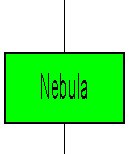

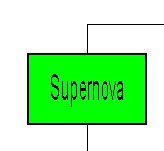



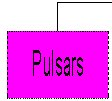
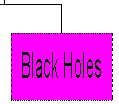
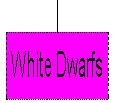
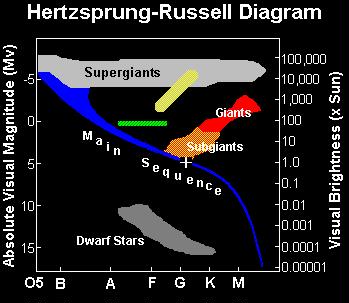
Two astronomers, Ejnar Hertzsprung and Henry Russell, independently had the idea of plotting a graph of luminosity (or true brightness) against surface temperature for every star in the sky.
The remarkable fact is that the points on the Hertzsprung - Russell diagram are, the points are grouped together in three district regions.
1) The upper-left to the
lower-right corners of the graph; these are called the main sequence stars.
The Sun is typical of a main sequence star.
2) Near the upper right-hand
corner of the diagram are stars that are cool and very bright. They emit
mostly reddish light. Almost every reddish-appearing star in the sky is
a red giant. They are thousands of times larger than the stars in the main
sequence; they are the largest stars in the universe.
3) The third group of dots
in the lower left-hand corner represents stars that are both dim and hot.
The only way such a hot star can be so dim is if it is small. These stars
are typically about the same size as the Earth, and in view of the blue-white
light emitted from their hot, tiny surfaces. They are called white dwarfs.
A nebula is a cloud of interstellar gas (hydrogen) and dust in space.
A nebula has 100,000's to few million solar masses start collapsing for some reason (shock waves, cool enough for gravity to take over, etc.).
Massive stars evolve quicker than less massive stars.
Evolution of stars depends on mass (at start of fusion only) with a tiny bit of dependence on chemical composition.
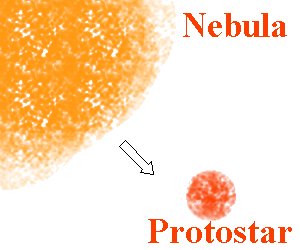
Gas clump collapsing and heating up in center as it collapses.
Gravitational energy being converted to heat.
Lots of Infrared and Microwave radiation produced.
Gets hot enough to glow red (2000-3000 K).
Evolved to what is known as T-Tauri stars.
T-Tauri--starlike object visible to outside.
Strong winds eject lots of material from young star
(preferentially along rotational axes). This is because of unstable equilibrium.
Cocoon gas/dust blown away. Star starts fusion.
 Fusion Process.
Fusion Process.
Procedes to main sequence stage.
Surface temperatures range from 3000ºC (M class) to above 30,000ºC.(O class)
The brightest stars have masses 100 times that of
the Sun and emit as much light as millions of Suns. Their lives are the
shortest.
The faintest stars are the red dwarfs, less than
one-thousandth the brightness of the Sun. They have the longest lifespan.
The smallest mass possible for a star is about 8% that of the Sun (80 times the mass of the planet Jupiter), for nuclear reactions to take place.
Objects with less than critical mass shine only dimly and are termed brown dwarfs or a large planet.
Star is stable because of Hydrostatic Equilibrium. Fusing Hydrogen to Helium in core.

Stars spends about 90% lifetime as main sequence.
Towards the end of its life, according to Chandrasekhar Limit, if the mass of the core is <1.44 solar mass, a white dwarf is formed. If the mass of the core is between 1.44 and 3 solar mass, a neutron star is formed. Any higher mass exist in the core, a black hole would likely be formed.
This is a large bright star with a cool surface.
It is formed during the later stages of the evolution
of a star like the Sun, as it runs out of hydrogen fuel at its centre.
Red giants have diameter's between 10 and 100 times
that of the Sun.
They are very bright because they are so large.
Their surface temperature is about 2000-3000ºC.
Stellar Nucleosynthesis in the giant stage.
- Creating heavier elements from lighter elements in stars.
- Fusion in core creates heavy elements up to Iron. (iron nucleus is
stable)
- Elements heavier than Iron are made in supernova explosion.
- Lowest mass stars can only synthesize Helium.
- Stars around the mass of our Sun can synthesize Helium and up to
Carbon.
- Massive stars, greater than 5 solar masses, can synthesize Helium,
Carbon, Oxygen, Neon, - Magnesium, Silicon, Sulfur, Argon, Calcium,
Titanium, Chromium, Iron.
Core fusion
When running out of core fusion fuel, core shrinks due to gravity.
As it shrinks, temperature rises. High enough temperatures is reached to start Helium (or heavier element) fusion.
The resultant sudden burst of energy causes the gas envelope, surrounding the core to puff out.
At the puffed out evvelope, the energy is spread out over a larger area so each square centimeter will be cooler making a red color.
Red giants can eject a lot of mass through ``winds'', making them less massive than the main sequence star it came from!
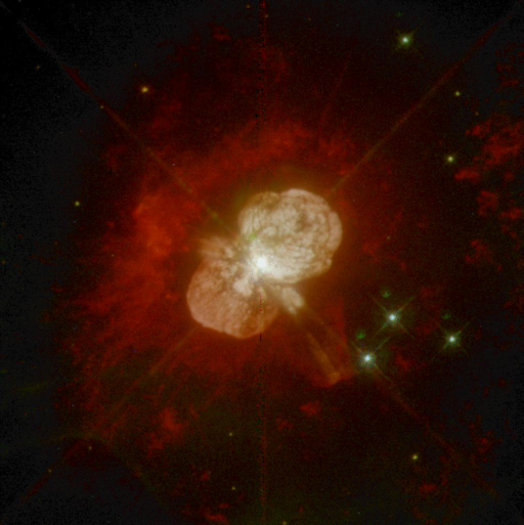 Ejection occurs like
this star, Eta Carinae.
Ejection occurs like
this star, Eta Carinae.
Fusion is releasing more energy to balance the increased gravity, so the star is bigger, but stable!
When core fuel runs out again, if massive enough, stellar nucleosynthesis of heavy elements occurs until carbon or iron. Interplay of gravity and nuclear fusion occurs in the core.
Death of Star
Planetary Nebula -- outer layers ejected as core shrinks to most compact state. Low mass star: 0.08-5 solar masses during main sequence) will go the planetary nebula route.
Low mass core about 1.4 solar masses shrinks to white dwarf. Electrons prevent further collapse.
White dwarfs with size about that of Earth.
Outer layers are planetary nebula.
This is very small, hot star, the last stage in the life cycle of a star like the Sun. White dwarfs are the shrunken remains of normal stars, whose energy supplies have been used up.
White dwarfs have a mass similar to that of the Sun, but only 1% of the Sun's diameter; approximately the diameter of the Earth.
The surface temperature of a white dwarf is 8000ºC or more, but being smaller than the Sun their overall luminosity's are 1% of the Sun or less.
White dwarf consist of degenerate matter with a very high density due to gravitational effects, i.e. one spoonful has a mass of several tonnes.
White dwarfs do not produce heat, they are radiating heat, so they cool and fade over several billion years.
Details
1. If core mass is smaller than 1.44 solar masses. Electrons are degenerate.
2. Neutrons and protons have room to move around freely.
3. Density about 106 g/cm3 (one sugarcube is heavier than a car!).
4. White dwarf cools off from initial formation temperature of about 100,000 K.
5. Seen when outer layers of red giant star puff out to make planetary nebula.
This is the explosive death of a star, and often results in the star obtaining the brightness of 100 million suns for a short time.
There are two general types of Supernova:-
Type I -These occur in binary
star systems in which gas from star falls on to a white dwarf, causing
it to explode.
Type II - These occur in
stars ten times or more as massive as the Sun, which uncontrolled nuclear
reactions at the ends of their lives, leading to an explosion. They leave
behind neutron stars and black holes.
Supernovae are thought to be main source of elements heavier than hydrogen and helium, carbon and iron.
Supernova-- high mass stars 5-50 solar masses. Supernova explosion happens because the core has formed a very stiff neutron star and the infalling outer layers rebound off it.
Higher mass core about 3 solar masses shrinks to neutron star.
Supernova happens when neutron star is created.
Neutrons prevent further collapse. Size about that
of a large city.
On the way to total collapse it may momentarily create a neutron star and the resulting supernova rebound explosion.
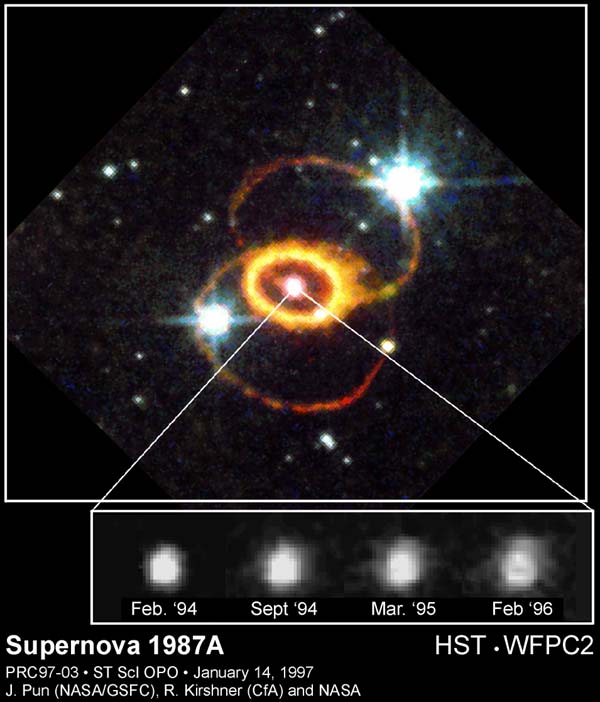 Type 2 Supernova, Sn1987
in LMC.
Type 2 Supernova, Sn1987
in LMC.
1) These stars are composed mainly of neutrons.
2) Which are produced when a supernova explodes, forcing the protons and electrons to combine to produce a neutron star.
3) Neutron stars are very dense. Typical stars having three solar mass are shrinked to a diameter of only 20 km.
4) If its mass is any greater, its gravity will be so strong that it will shrink further to become a black hole.
5) Pulsars are believed to be neutron stars that are spinning very rapidly.
 There is a neutron star in this
Crab Nebula.
There is a neutron star in this
Crab Nebula.
Processes :
If the mass of the core exceeds 1.4M (the Chandrasekar Limit) electron degeneracy pressure will be insufficient to support the star against collapse
Collapse continues until remnant is 20km across.
Electrons are squeezed into the protons producing an object made almost entirely of neutrons, resembling a gigantic atomic nucleus.
At this density, “neutron degeneracy pressure” supports the star against collapse, as long as the remnant is no more massive than 3M.
Since the star conserves angular momentum as it collapes, thus it spins more rapidly.
A Neutron Star rotates about once per second!(Pulsar)
The collapse of the Neutron Star also intensifies the star's magnetic field.
The star beams intense radio radiation from its magnetic poles.
Pulsars :
a) They rotate fast because of conservation of angular momentum.(Recall)
b) Charged particles (mostly electrons) flow out of the magnetic poles.
c) As the charged particles spiral around the magnetic field lines,
they produce a beam at the magnetic poles.
d) If the beam sweeps past Earth, we see a flash of light.
e) Radiation production causes pulsar to lose energy so pulsar rotation
slows down as angular momentum slowly decrease.
When core mass > 3 solar masses (Chandrasekhar limit).Gravity finally wins, compressing core to mathematical point (singularity) at center.
Formed in supernova explosion.
Surface gravity so strong that nothing can escape (not even light!) within a certain distance from mass point.
Boundary is called the event horizon (or Schwarzchild radius)
No messages of events happening within radius.
How to detect Black Holes:
In binary where the black hole is a companion
Use Kepler's 3rd law to find sum of masses. Guess mass of visible companion then find unseen companion's (black hole's) mass.
Look for X-rays produced in hot accretion disk.
Friction increases inward, causing increasing temperature
as the sucked in material approach the event horizon
This produces wide spectrum of radiation. To make
rapidly varying X-rays, unseen companion must be small!
